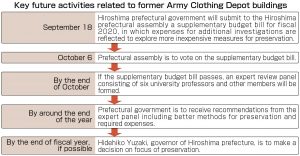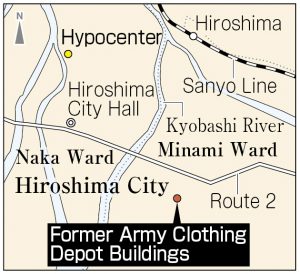Hiroshima governor indicates possible reduction of anti-seismic expenses to one-third current estimate for preservation of former Army Clothing Depot
Sep. 5, 2020
by Koji Higuchi, Staff Writer
On September 4, Hidehiko Yuzaki, governor of Hiroshima Prefecture, revealed the possibility that anti-seismic construction costs for one of the former Army Clothing Depot buildings, located in Hiroshima’s Minami Ward, could be reduced to one-third of 2.8 billion yen among the 3.3 billion yen required for preservation and utilization of the building. The buildings are among the largest A-bombed structures remaining in Hiroshima city. If the new plan is put into effect, anti-seismic construction costs for all three buildings could be decreased to a total of about 3.0 billion yen. The plan will be finalized after an in-depth investigation is launched in October with the aim of gathering feedback from experts. By the end of this fiscal year, the prefectural government plans to announce its new direction for preservation of the buildings.
Based on seismic testing conducted in fiscal 2017, which noted that the buildings were at risk of collapse, the prefectural government estimated the costs necessary for seismic retrofitting. With consideration paid to the impact on the prefecture’s finances, the government announced in December 2019 its original proposal for applying safety measures to the buildings, which involved demolition of two buildings and preservation of one building’s exterior.
In a press conference held at the prefectural government offices, Mr. Yuzaki said, “The new assessment drastically alters our assumption regarding building preservation. We will conduct a detailed investigation and consider the direction we want to move in.” Asked about how the buildings would be utilized if preserved, he shared his thoughts by saying, “We might consider that as a separate issue.”
The prefectural government examined the anti-seismic performance of the brick structures by utilizing an old brick wall that once surrounded the former Army Clothing Depot but was removed this past March for safety reasons. Both the former Army Clothing Depot buildings made of concrete and brick and the nearby brick wall were built around the same time. The testing results showed that the strength of the mortar joints, an area critical for earthquake resistance, was in actual fact 2.6- to 2.7-times greater than the strength identified at the time of the previous investigation in 2017.
Based on the results, the anti-seismic performance of the buildings was assessed in a simplified manner, under the assumption that the buildings would be reinforced with additional braces and repaired cracks. With that, it was concluded there would be a low risk of collapse even if the buildings were hit by an earthquake of 6-7 seismic intensity. Accordingly, it was deemed unnecessary to use earthquake shock absorbers, devices that were estimated to be necessary in the previous investigations, leading to the significant cost reduction.
During the previous seismic testing that took place in 2017, standard industry values were adopted for calculating the strength of the buildings’ joints. Mr. Yuzaki explained, “We were not able to do actual testing for confirmation of joint strength because it wasn’t possible to use the wall of the building. We believe we did the best we could at the time in terms of the testing based on our own consultations with experts.”
The prefectural government will set up a review panel in October consisting of six experts knowledgeable in the area of historical structures. The panel is expected to comprehensively test the strength and anti-seismic performance of the buildings and provide recommendations for safety measures to the prefecture, along with estimated costs, by the end of December. According to several people involved in the process, when the supplementary budget bill for the general account in fiscal 2020 is proposed at the plenary session of the prefectural assembly, scheduled to begin on September 18, about 30 million yen will be included in the bill for relevant expenses.
Former Army Clothing Depot
The former Army Clothing Depot is a facility once used to manufacture uniforms and footwear for the former Imperial Japanese army. The facility buildings, located 2.7 kilometers southeast of the hypocenter, were completed in 1913. The depot originally consisted of 13 buildings, but now only four remain in an L-shaped configuration. The Hiroshima prefectural government owns buildings No. 1 through No. 3, while building No. 4 is owned by the national government. In December 2019, the prefectural government released its original plan calling for demolition of two of its buildings and preservation of the other building’s exterior as a safety measure, given that the deteriorated condition of the buildings, which are more than 100 years old, might lead to collapse in the event of an earthquake, with the potential for damage or injury to neighboring residents or passersby. However, responding to requests from the prefectural assembly and others, the prefectural government postponed the original schedule for initiation of demolition work in fiscal 2020. As for building No. 4, the national government has revealed that it is to determine its own policy based on the results of the prefectural government’s deliberations.
(Originally published on September 5, 2020)
On September 4, Hidehiko Yuzaki, governor of Hiroshima Prefecture, revealed the possibility that anti-seismic construction costs for one of the former Army Clothing Depot buildings, located in Hiroshima’s Minami Ward, could be reduced to one-third of 2.8 billion yen among the 3.3 billion yen required for preservation and utilization of the building. The buildings are among the largest A-bombed structures remaining in Hiroshima city. If the new plan is put into effect, anti-seismic construction costs for all three buildings could be decreased to a total of about 3.0 billion yen. The plan will be finalized after an in-depth investigation is launched in October with the aim of gathering feedback from experts. By the end of this fiscal year, the prefectural government plans to announce its new direction for preservation of the buildings.
Based on seismic testing conducted in fiscal 2017, which noted that the buildings were at risk of collapse, the prefectural government estimated the costs necessary for seismic retrofitting. With consideration paid to the impact on the prefecture’s finances, the government announced in December 2019 its original proposal for applying safety measures to the buildings, which involved demolition of two buildings and preservation of one building’s exterior.
In a press conference held at the prefectural government offices, Mr. Yuzaki said, “The new assessment drastically alters our assumption regarding building preservation. We will conduct a detailed investigation and consider the direction we want to move in.” Asked about how the buildings would be utilized if preserved, he shared his thoughts by saying, “We might consider that as a separate issue.”
The prefectural government examined the anti-seismic performance of the brick structures by utilizing an old brick wall that once surrounded the former Army Clothing Depot but was removed this past March for safety reasons. Both the former Army Clothing Depot buildings made of concrete and brick and the nearby brick wall were built around the same time. The testing results showed that the strength of the mortar joints, an area critical for earthquake resistance, was in actual fact 2.6- to 2.7-times greater than the strength identified at the time of the previous investigation in 2017.
Based on the results, the anti-seismic performance of the buildings was assessed in a simplified manner, under the assumption that the buildings would be reinforced with additional braces and repaired cracks. With that, it was concluded there would be a low risk of collapse even if the buildings were hit by an earthquake of 6-7 seismic intensity. Accordingly, it was deemed unnecessary to use earthquake shock absorbers, devices that were estimated to be necessary in the previous investigations, leading to the significant cost reduction.
During the previous seismic testing that took place in 2017, standard industry values were adopted for calculating the strength of the buildings’ joints. Mr. Yuzaki explained, “We were not able to do actual testing for confirmation of joint strength because it wasn’t possible to use the wall of the building. We believe we did the best we could at the time in terms of the testing based on our own consultations with experts.”
The prefectural government will set up a review panel in October consisting of six experts knowledgeable in the area of historical structures. The panel is expected to comprehensively test the strength and anti-seismic performance of the buildings and provide recommendations for safety measures to the prefecture, along with estimated costs, by the end of December. According to several people involved in the process, when the supplementary budget bill for the general account in fiscal 2020 is proposed at the plenary session of the prefectural assembly, scheduled to begin on September 18, about 30 million yen will be included in the bill for relevant expenses.
Keywords
Former Army Clothing Depot
The former Army Clothing Depot is a facility once used to manufacture uniforms and footwear for the former Imperial Japanese army. The facility buildings, located 2.7 kilometers southeast of the hypocenter, were completed in 1913. The depot originally consisted of 13 buildings, but now only four remain in an L-shaped configuration. The Hiroshima prefectural government owns buildings No. 1 through No. 3, while building No. 4 is owned by the national government. In December 2019, the prefectural government released its original plan calling for demolition of two of its buildings and preservation of the other building’s exterior as a safety measure, given that the deteriorated condition of the buildings, which are more than 100 years old, might lead to collapse in the event of an earthquake, with the potential for damage or injury to neighboring residents or passersby. However, responding to requests from the prefectural assembly and others, the prefectural government postponed the original schedule for initiation of demolition work in fiscal 2020. As for building No. 4, the national government has revealed that it is to determine its own policy based on the results of the prefectural government’s deliberations.
(Originally published on September 5, 2020)









